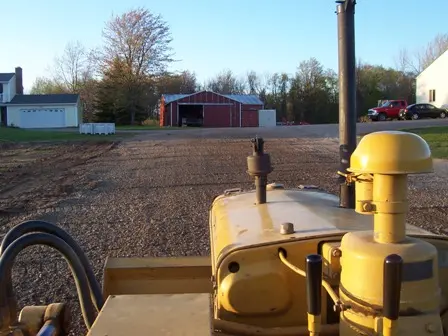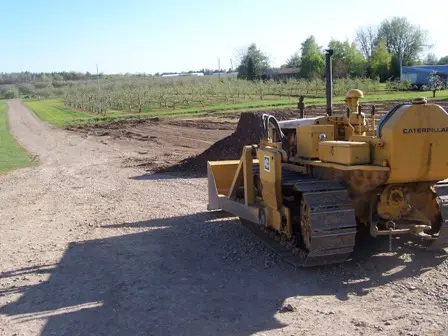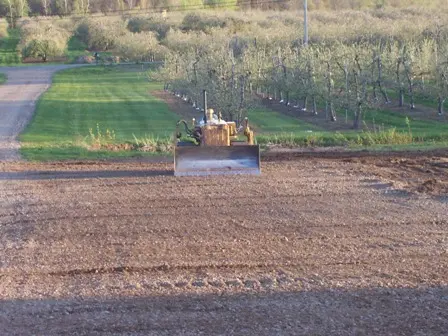What you are descibing is a common affliction for new operators. We have all gone through it. Some of us still do the dip and dive on occasion. Just keep trying and you will learn to anticipate what the dozer is up to. Your finish work should be to backdrag with the dozer. Give it time and before long you will be a good operator. Best of luck on your project. Marty
I have very little experience on a dozer as well. I have learned that if you can keep the blade closer to "full" than not it will push much better. Then do the back drag to smooth. I know some wince at the thought of back dragging but untill I get better it is a necessary evil for me...... 😊
Have a good day....Bill
to see some of the better operators on there with a small tractor. The biggest trick with a D2 is to think about 3 or 5 feet ahead of only one corner of the blade. You don't care about the other corner, it follows the one you are watching.
Where you are grading on a right of way you want to stay a little higher than it. Start on the edge of the pile, go straight out, back up, move over to cut a little more of the pile, push it out. The bigger part of the pile will fall down as you work across it. Back dragging is acceptable but SOME people say never do it. I can grade with a D2, BUT I do OCCASIONALY backdrag too! It covers up screw ups! Anyways when you are looking out a ways in front of you instead of intently trying to adjust and stare at the whole cut. You end up jerking the blade up and down. If you do a long cut and get a bump in it where you raised the blade for whatever reason. Back up to that mistake and start your correction right there going only farther enough to straighten it up or back drag the fill back over the mistake and level it into the point just prior to where you raised the blade and made the bump. Too many guys are continously trying to raise and lower the blade like a high speed, high pressure hydraulic system attached to a laser. Another thing is half throttle and first gear is plenty fast enough. Practice, practice! Patience, patience! You are not going to buy a tractor, jump on it and start dozing like a pro. It took a lot of years for the good operators to get good.
Jeff
[quote="Weekend Dozr"]I figured this might take some time but eventually I'd get the hang of dozing like the pro's. Not yet. I've got about six piles of 4-6 yards of free fill dirt all along the one side of my driveway. I'm dumping there to smooth out and bring that side level with the driveway. Currently it slopes down slightly and during our heavy snowstorms I've gotten stuck while plowing there a few times - plus a level area will improve the lot and allow more parking for more toys, (old dump truck may be next).
So I've pushed the piles back from the road good enough but as I've tried to doze parallel to the driveway the blade has gone high, and also dipped to low resulting from the tilt of the machine while driving over the uneven surface. I even have a place where I dug lower than the driveway which I must now fill in. At this point I had to stop yesterday when I found water in the transmission oil - will refill tonight and get back to it. I am getting best results now from pulling the dropped blade backwards. Is that how I should be working or do I just need to go slower and keep my blade even with the level I'm trying to keep while the machine keeps moving up/down? What a strong machine![/quote]
all good advice so far. One more tip I might throw in is to remember that whatever slope or angle the tractor is setting on is the angle or slope that the blade will want to make. If you can get a good flat spot started, then always go back to there before making another pass in the loose dirt. You will be packing the already level spot and not as apt to make so many dips and dives. Backdragging is always a good way to smooth things out and clean up grouser tracks. A lot of high speed backing will eventually wear out the pins and bushings on the back side. Everybody always roaded the machines backward simply because they didn't like to eat all the dirt!
Gosh!! I never had a problem with dip and dive especially with a 4 roller D2😆
Seriously, In my limited experience with a blade the pointers in this thread are valuable to me.
Thanks Weekend Dozr for starting this thread
About the only time I use the float position is winter when I'm shoving snow around on an already iced or packed road. I've tried it a few times on a fairly hard surface moving dirt but it seems that if a rock gets rolled under the blade it tends to bounce up and over it.
When I first started Bulldozing as a young feller, I can remember the old boss on the job telling me not to backblade because it wears the heads off of the cutting edge bolts. Every once in a while I would catch him backblading though, I know he had at least 20,000 hours running a D7-E plus many other machines. Funny thing was that we always had to tourch the bolts out anyway when it came time to change the cutting edges. The other thing is to work in multiple angles where there is room. If you can attack the job at 120 degree angles that will fill in some of the bumps that were created on the previous passes and after a while everything just fills in once you have a handle on the blade. Keep in mind that the best machine for road work is a Road grader. You will never get it as good with a Bulldozer as you can with a grader. Dandy Dave!



While not the best operator I can manage to do a OK job. Full blade is easier, muliple passes moving side to side, or at angle does help. I have run a D6D for a few days, and it was a much easier tractor to run than the D2. If a wash board starts sometimes it is better to stop, back up and start a new pass. Here a a few pics of a parking area I put in for my brothers winery. Pushed off the top soil, and spread 5" to 6" bank gravel. Yes I back bladed to finish.